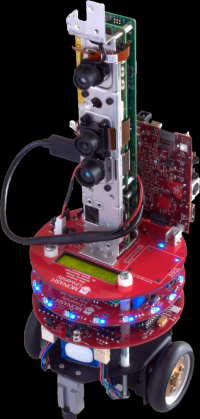More than meets the eyeBug

When you think of robots, you probably think of Arnold Schwarzenegger walking round with part of his metal skull exposed in the Terminator films, or C3PO being the model of politeness in Star Wars. The field of robotics, and the technology within it, is advancing quickly and tomorrow’s truth may soon resemble yesterday’s science fiction.
Today, robots are used for industrial tasks such as manufacturing, mining and inspection, as well as being an important research tool.
As part of his final year project, Monash engineering student, Nick D’Ademo has designed an experimental robot called eyeBug, under the supervision of Dr. Ahmet Sekercioglu from the Department of Electrical and Computer Systems Engineering.
“When I gave Nick the specification, I had no idea what a beautifully flexible design he would create. We wanted a design that would be cheap to build, modular to be open for innovation and creativity, and finally something that would be visually appealing for other students,” Dr. Sekercioglu said.
“Design is an integral part of our engineering students’ curriculum where they are given the challenge of taking an idea and develop it into a fully functioning system. It is extremely rewarding for us to see the students applying the principles we teach so successfully.”
The resulting robot has attracted a lot of attention and is already being used for a wide range of research projects.
By studying the way robots form networks to communicate with each other, it is possible to gain indispensable knowledge that will be used to develop the next generation of smart mobile phones.
Nick D’Ademo and Dr. Sekercioglu will “open-source” the eyeBug design and release all the programs and system design documents to the internet community, establishing university-to-university collaboration links in various projects.
Dr. Sekercioglu’s postgraduate students have already started developing technologies to extend the robot’s capabilities to create distributed smart camera networks. Eventually, swarms of eyeBugs equipped with artificial intelligence algorithms will be able to build digital 3D models of their environment by communicating and sharing what every individual eyeBug sees.
“Robots are already vital to the way we live today. They’ve changed the way we approach activities, and they are becoming ‘networked’. For example, a team of eyeBugs could potentially be used to map out a scene inside a building after an earthquake, or a nuclear reactor after an accident,” said Dr. Sekercioglu.
Other researchers are also keen to get their hands on the eyeBug including Professor Tom Drummond who leads the Augmented Reality research group at Monash University.
“Augmented reality is a new and exciting field in which a view of a physical environment is overlaid with computer-generated video or graphics.
“The eyeBugs, with their vision processing and distributed computation capabilities, will be a real benefit,” said Professor Drummond.
Tomorrow’s technology may arrive sooner than you think!
More information: For further information on Electrical and Computer Systems Engineering, visit www.eng.monash.edu.au/ecse/
Provided by Monash University




















